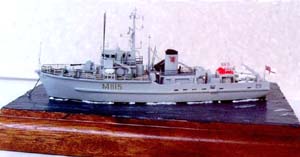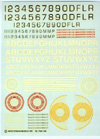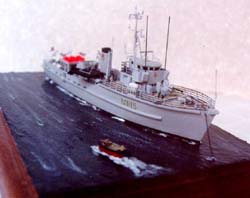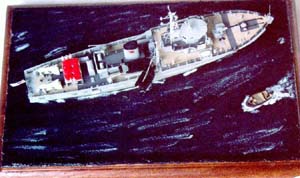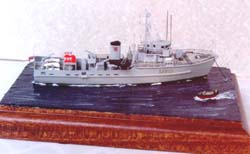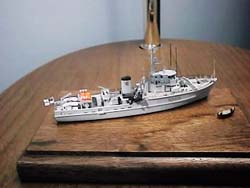White Ensign Models 1/350 Resin Ton Class Minehunter HMS Bronnington
By Felix Bustelo
Introduction
As a result of the experience gained from World War II, the need for coastal and inshore mine countermeasure ships became apparent. Large ocean minesweepers were not adequate for coastal and inshore waters, so a new design was sorely needed.
After several years of development on the drafting table, the Ton Class minesweeper was born and it is arguably one of the most successful designs, with over one hundred ships constructed between 1951 and 1960. More than 30 ships have been transferred to British Commonwealth and foreign navies.
The Ton Class ships were designed to sweep both moored and ground mines. To minimize the ship's magnetic field, these ships were constructed almost totally from light aluminum alloy and other materials. The one exception is the double mahogany hull planking. A "Cascover" nylon protective sheathing was fitted below the waterline to prevent damage from underwater parasites. The result of this design and construction is a ship that is well suited for coastal minesweeping with the lowest possible magnetic field but is sturdy enough to withstand ocean-going voyages. Eighteen Ton Class vessels were subsequently converted to minehunters, which involved removal of the sweeping gear, installation of Type 193 minehunting sonar and active twin rudders which allowed these ships to position themselves close to a mine so that divers could be deployed to blow it up. Some vessels also carried a Sperry Towed Acoustic Generator.
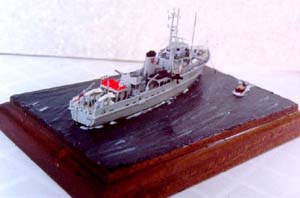 The HMS Bronnington was launched on March 19, 1953 and she served in various minesweeping squadrons before she was converted to a minehunter in 1963. During this refit, the Bronnington had her bridge enclosed and a tripod mast and the latest sonar equipment fitted. She served mostly off the British, western European and Scandinavian coasts. In 1974, she joined the 1st Mine Counter Measures Squadron based out of Rosyth in Scotland. From February through December of 1976, His Royal Highness Prince Charles, then a Lieutenant, was the Commanding Officer of the Bronnington.
The HMS Bronnington was launched on March 19, 1953 and she served in various minesweeping squadrons before she was converted to a minehunter in 1963. During this refit, the Bronnington had her bridge enclosed and a tripod mast and the latest sonar equipment fitted. She served mostly off the British, western European and Scandinavian coasts. In 1974, she joined the 1st Mine Counter Measures Squadron based out of Rosyth in Scotland. From February through December of 1976, His Royal Highness Prince Charles, then a Lieutenant, was the Commanding Officer of the Bronnington.
In the 1980s, the Bronnington served in the 2nd Mine Counter Measures Squadron, as part of the NATO Standing Naval Force Channel and in the Fishery Protection Squadron before she was paid off on June 30, 1988. The Bronnington, affectionately nicknamed "Old Quarter Past Eleven" because of her pennant number 1115, is current owned by the Bronnington Trust and is preserved as a museum in Manchester, England.
The Kit
The White Ensign Models HMS Nurton kit was released in 1996 and has proven to be a very popular seller. This kit is an excellent choice for your first foray into resin but it is just as enjoyable for the more seasoned ship modeler. The kit is very simple to build and the photoetch brass provided, while not too difficult to work with, does present some nice challenges. The kit master and the photoetch design were made by Peter Hall. The larger resin parts are comprised of the waterline hull, the bridge superstructure and the funnel. A small ziplock bag contains the smaller resin parts:
Four magnetic sweep buoys
40mm Bofors
two Gemini inflatable rafts
two outboard motors
marker buoys/sweep winch housing platform
sweep winch
winch spool
anchor windlass
cable reel
two liferaft canisters
A piece of square styrene is also provided for use as the Gemini crane around which the photoetch part is suppose to be wrapped around. The resin parts are very cleanly cast and required only a little bit of clean up, such as removing some casting plugs and light sanding in spots.
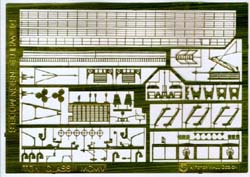 |
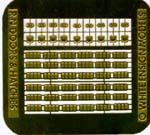 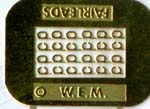 |
The model comes with three brass photoetch sets: two sets of more general items that are also sold separately and a detail set specifically designed for this model. The generic sets include watertight doors (WEM PE3503) and fairleads, or chocks to Americans like me, (WEM PE3511). The detail set for the kit includes:
tripod mast components and yardarms
sweep davit handwheels
"U" bend vents
anchors and anchor cables
radar scanner and D.F. aerial
inclined and vertical ladders
Gemini launch crane and stowage platform
sweep buoy stowage racks
liferaft canister stowage racks
sweep davits
sweep winch housing
radar reflector sides
stern guides and guard rails
jackstaff
3-bar and 2-bar railing.

